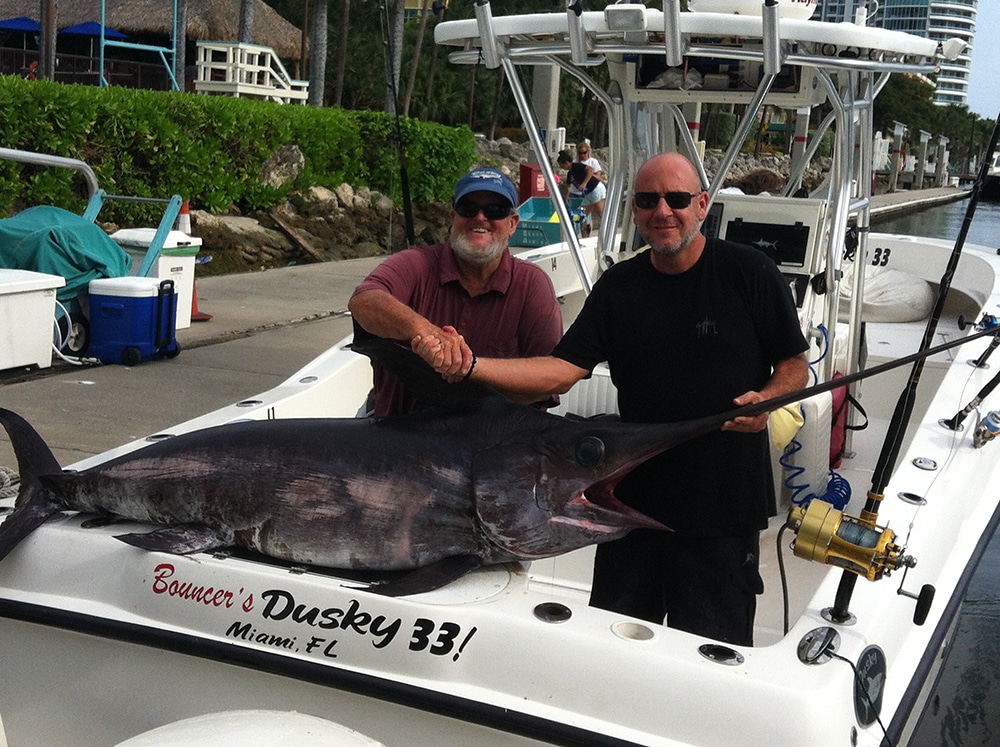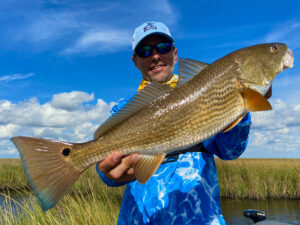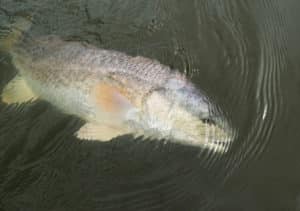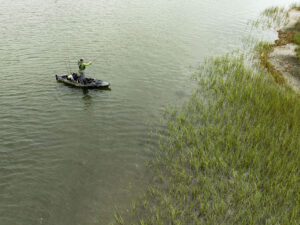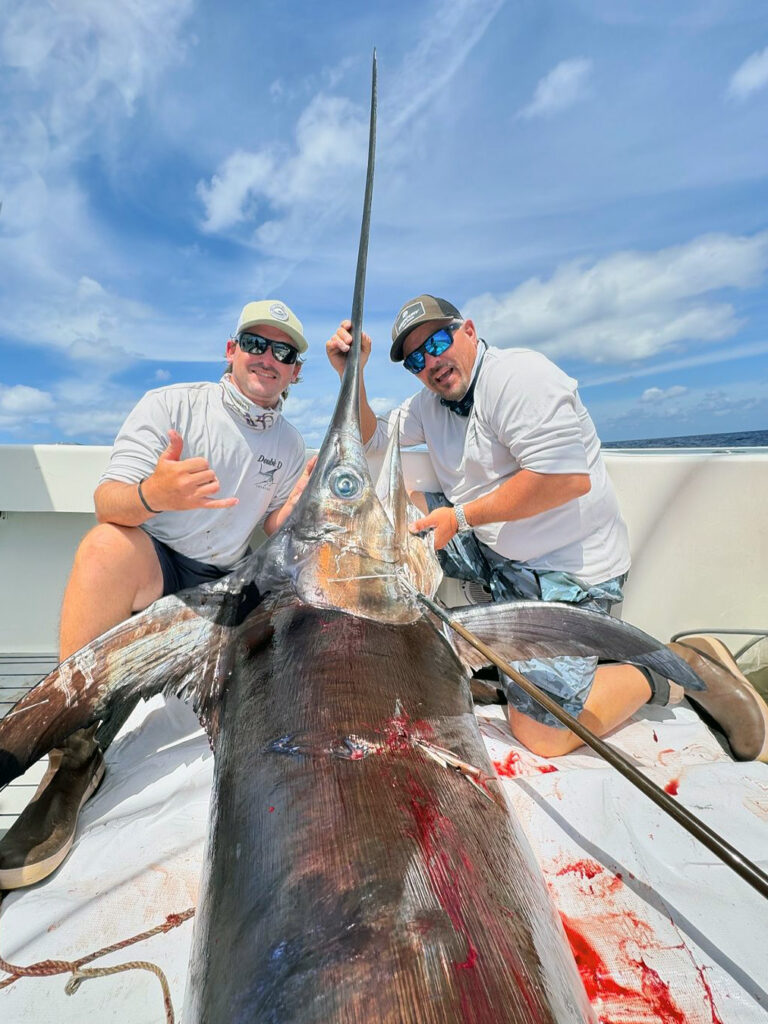
The exceptional swordfishing off South Florida sometimes gets lost in the hustle and bustle of Miami’s and West Palm Beach’s dazzling lifestyles. But many offshore fishermen want in on the action, and they’re quickly realizing the fishery outshines anything happening on the mainland.
Just miles off the coast are clean blue waters and deep-water humps that attract juvenile and adult swordfish year-round. Even though the swordfish are there, specialized tackle is required to catch them in depths deeper than 1,000 feet.
Before heading out by yourself, consider chartering one of the many exceptional captains that target this deep-water billfish on a regular basis. I asked top pros Capt. Dean Panos and Capt. Jay Cohen to talk about their techniques and experiences offshore. Ever since long liners were kicked out of the Florida Straits, fishermen continue to report increased catches and larger fish on a regular basis. Use the tips below to better prepare for your next trip:
What’s your basic rig for nighttime swordfishing?
Panos: At night, we fish strictly conventional reels. You can go with either 50s or 80s. I use a 2-speed reel and a custom stand up rod with a short bent butt. The reels are loaded with 80-pound monofilament ending with a short double line via a Bimini twist. I then add a 50-foot wind-on leader of 250-pound test. (If fishing strictly IGFA regulations, then the wind-on is cut back to 25 feet.)
At the end of the wind-on is a crimped ball bearing swivel. At the other end of the swivel, we crimp a bait with a short 5-foot section of 250-pound-test monofilament leader. On the wind-on, toward the top, I floss two loops. One is for the weight (usually 32 ounces). The other is 5 feet away from the lead to attach a light.
How many lines do you use at night for swordfishing?
Panos: I fish 5 or 6 rods at night. My first rod is usually a live bait — either a blue runner, goggle eye, tinker mackerel, or speedo. Those are my baits of choice. The live bait is flossed onto a 9/0 J hook. The floss is through the eye cavity, but not through the eye itself. Floss the bait on tightly so the hook doesn’t have room to swing and hook back through the bait.
I drop the first rod down 300 feet. All my rods have floss loops on the line at 100, 200 and 300 feet. At the 300-foot loop, I attach a buoy. On the stick of the buoy. I add Cyalume sticks so I can see the float. I float this rig out at least 150 yards or more.
The second rod is a dead squid rigged with a 9/0 hook and that is dropped down 200 feet, float attached, and floated out about 100 yards. The third bait is a live bait or a dead squid dropped down 100 feet. A float is attached and drifted out about 50 yards.
Next, I fish a “tip” rod in the stern corner with a squid dropped down 300 or 400 feet. The rod tip aims straight off the back corner. (A tip rod is one that does not have a buoy or jug attached to it. The line goes straight from the tip of the rod into the water.) I fish a second tip rod with a live bait down about 100 feet; this is usually hooked with a live bait and is fished off of the bow.
Depending on moon, current and other conditions, I may fish a flatline with only a light, live bait and no lead. I usually fish the flatline when there is no moon and the swords are higher in the water column.
How does daytime swordfishing differ from nighttime trips?
Panos: The daytime fishing is completely different. You basically drop a single bait to the bottom in 1,600 to 1,800 feet of water and reel it off the bottom 50 to 100 feet. The daytime fishery has been better in the past couple of years.
What’s your basic rig for daytime swordfishing?
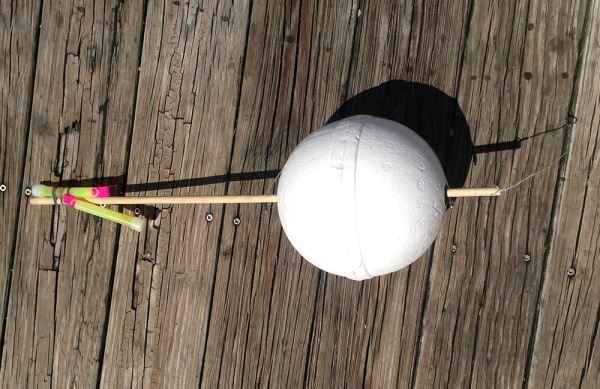
Panos: For daytime fishing, I prefer to use a Penn Hooker Electric 80 electric/manual combo reel. The Penn Hooker Electric reel has a handle that works both in low and high gear. If you do get a bite, you can manually fight the fish with the handle. On the other hand, the reel also has an electric motor, so if you need to check the bait or relocate, you can use the electric portion of the reel to bring up your rig.
The reel is loaded with 80-pound braid. That is attached to a 150-foot wind-on leader of 250-pound test. At the end of the wind-on, we crimp on a ball bearing swivel. Then, we crimp on our bait that’s on a 5-foot section of 300-pound test and attached to a 10/0 or 11/0 hook.
At the top of the wind-on is a floss loop, which is securely tied to the mono section to ensure it does not slide. I attach a 10- to 12-pound lead weight with a snap onto the floss loop. The lead is tied to 5 feet of 60-pound-test monofilament.
On the wind-on, about 15 to 25 feet from the bait, I use two flashing strobes. These are passed through the line and secured in place with rubber bands. When you do get a fish close to the boat, these lights will slide through the line, allowing you to bring the fish right up to the swivel section. The rubber bands are used to keep the lights from sliding as you drop your bait. I prefer two strobes: one green and the second blue.
The Buoy Rod for Swordfish
Besides the primary “tip” rod, we also use a secondary “buoy” rod. The buoy rod has specific rigging to accommodate the buoy. After letting out 1,600 feet of braided line, we have a wind-on leader rigged, and that’s where the buoy is attached. Some anglers use rigging floss to attach the buoy, but heavy pressures on the buoy and floss can break the connection. So we don’t use the rigging floss.
The downside of the buoy rod is that an angler can’t re-drop or re-deploy the bait, as with the tip rod. But a buoy rod does allow a second bait presentation in a different location than the primary rod. The bait on the buoy sits as high as 600 to 800 feet off the bottom due to currents and boat drift. Let’s say a swordfish is hanging 300 feet off the bottom, it’s likely to eat the bait on the buoy rod.
What are you looking for on the depthfinder when swordfishing?
Panos: In Miami, we fish a drop-off between 1,200 and 1,600 feet of water at night. During the daytime, the depths range from 1,600 to 1,800 feet. This area has a ridge with lots of ups and downs on the bottom that in turn create upwellings and usually hold bait. Bait is usually squid, deep-water sardines and sometimes tinker mackerel. Inshore of the ridge is usually pretty flat bottom and offshore of the ridge it drops off to 2,000 feet.
The key is to keep your bait near the bottom but avoid snagging the bottom. We usually fish offshore of the ridge in areas with less ups and downs on the bottom, but with areas that do have large humps and depressions. You seem to catch more fish in the front and just behind most of the holes or mounds. You need to watch your depth recorder and adjust your bait up and down keeping close to the bottom but avoid snagging the bottom.
What are the top swordfish baits?
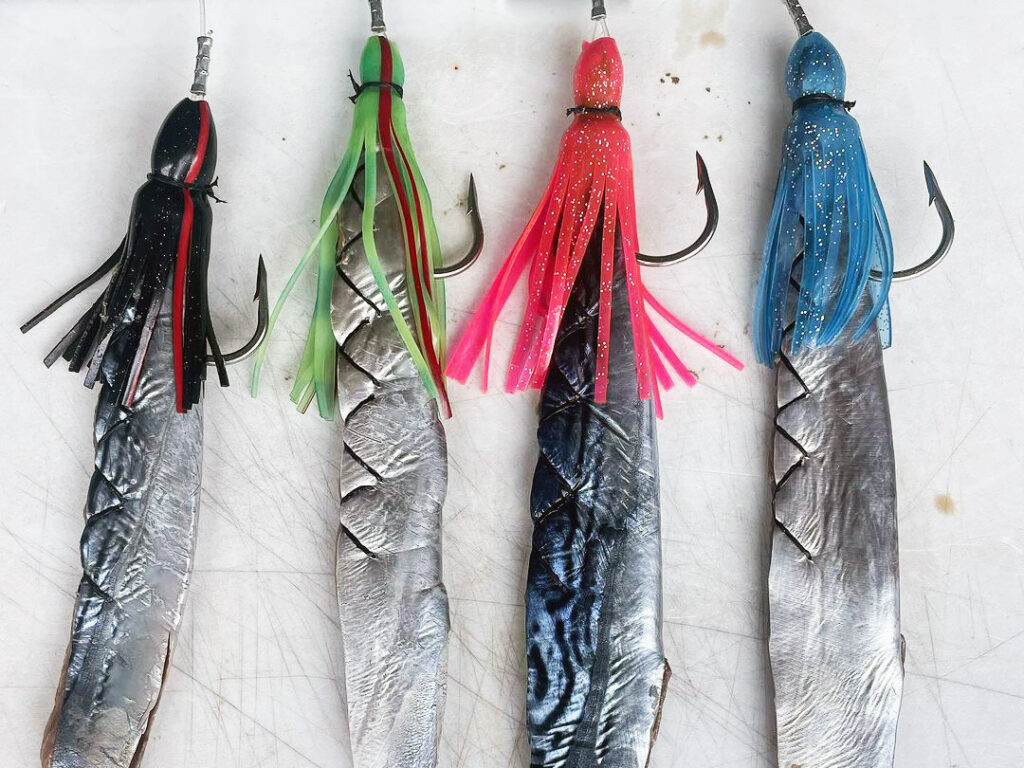
Panos: During the day, we use baits that are fairly durable and can withstand a sword’s brutal attack. We often used bonito strips rigged Panama-style with a large skirt over them. We also use dolphin strips, bonito bellies, dolphin bellies, squid tentacles, eels, or dead squid stitched well to the hook.
What’s the average size swordfish caught off South Florida?
Panos: My biggest fish to date is 605 pounds. That was caught during the day. At night, the biggest fish was around 460 pounds. Average size swordfish during the day is 100 to 300 pounds, and average at night is 50 to 200 pounds.
What is your favorite color of swordfish light?
Panos: Although the color of the Lindgren Pitman swordfish lights that we use are really not a factor, I favor blue, green or purple, as well as a tri-color light (blue/green/white) and a two-color light (blue/green) at night.
Backward “Back” Trolling for Swordfish
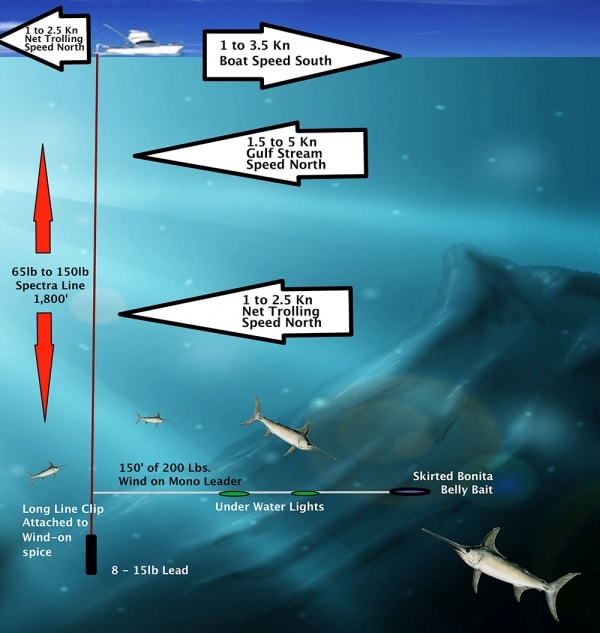
Cohen: We typically have to fish through the strong Gulf Stream current, so South Florida daytime swordfish fishermen have developed a few specialized techniques. We deploy the rig into the water facing north. As we pay out the, line I will run the boat north at about 10 knots with the current. Once the bait is below the current, about 600 feet down, we stop our forward movement.
Next, we spin the boat around to the south and start heading into the current. The goal is to get the line straight down off the back of the boat. Once we hit the bottom we bring the bait up about 100 feet. Every few minutes we will pay out line to find bottom again, then come back up 100 feet. Sometimes when the current is running fast we will have nearly 3,000 plus feet of line off the reel to hold the bottom in 1,800 feet of water. Eventually you find the “sweet spot,” the amount of line belly that keeps the bait in position.
The ultimate goal is to have the bait trolling just above the bottom at about 1.5 knots. To achieve this we will move the boat south into the current at about 1.5 to 3.5 knots. The net result is the boat and bait will be going north or “backward” at 1.5 knots.
To maintain this all day I like to use my electronics. I will set my chart plotter with a course line and an indicator telling me were I will be in two minutes. This helps me maintain a proper course and speed at a glance. Once I find the right heading that keeps us moving the correct direction against the current and prevailing wind I will engage the autopilot to help maintain course.
